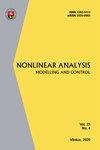具有Cattaneo–Christov热通量、熵产生和随时间变化的压力梯度的两个垂直多孔壁之间的非牛顿铁纳米流体的MHD流动
IF 2
3区 数学
Q1 MATHEMATICS, APPLIED
引用次数: 0
摘要
本文研究了具有Cattaneo–Christov热通量和熵产生的非牛顿纳米铁流体在两个垂直渗透壁之间的随时间变化的压力梯度下的磁流体动力学流动。在本研究中,血液被认为是非牛顿流体(偶应力流体)。研究了纳米颗粒的形状因子、焦耳加热、粘性耗散和辐射热影响。这项研究在纳米药物递送、制药过程、微电子、生物医药和生理流体动力学方面至关重要。通过部署摄动过程,将流量控制偏微分方程转化为常微分方程组,然后在射击方法的辅助下用Runge–Kutta四阶程序处理。采用Hamilton–Crosser模型分析了不同形状纳米颗粒的热导率。结果表明,Eckert数的增加会导致更高的温度,而热弛豫参数的增加则相反。热传递速率随着热辐射的增加而增加。熵随着热弛豫参数的增大而减小。本文章由计算机程序翻译,如有差异,请以英文原文为准。
MHD flow of non-Newtonian ferro nanofluid between two vertical porous walls with Cattaneo–Christov heat flux, entropy generation, and time-dependent pressure gradient
This article studies the magnetohydrodynamic flow of non-Newtonian ferro nanofluid subject to time-dependent pressure gradient between two vertical permeable walls with Cattaneo–Christov heat flux and entropy generation. In this study, blood is considered as non-Newtonian fluid (couple stress fluid). Nanoparticles’ shape factor, Joule heating, viscous dissipation, and radiative heat impacts are examined. This investigation is crucial in nanodrug delivery, pharmaceutical processes, microelectronics, biomedicines, and dynamics of physiological fluids. The flow governing partial differential equations are transformed into the system of ordinary differential equations by deploying the perturbation process and then handled with Runge–Kutta 4th-order procedure aided by the shooting approach. Hamilton–Crosser model is employed to analyze the thermal conductivity of different shapes of nanoparticles. The obtained results reveal that intensifying Eckert number leads to a higher temperature, while the reverse is true for increased thermal relaxation parameter. Heat transfer rate escalates for increasing thermal radiation. Entropy dwindles for intensifying thermal relaxation parameter.
求助全文
通过发布文献求助,成功后即可免费获取论文全文。
去求助
来源期刊

Nonlinear Analysis-Modelling and Control
MATHEMATICS, APPLIED-MATHEMATICS, INTERDISCIPLINARY APPLICATIONS
CiteScore
3.80
自引率
10.00%
发文量
63
审稿时长
9.6 months
期刊介绍:
The scope of the journal is to provide a multidisciplinary forum for scientists, researchers and engineers involved in research and design of nonlinear processes and phenomena, including the nonlinear modelling of phenomena of the nature. The journal accepts contributions on nonlinear phenomena and processes in any field of science and technology.
The aims of the journal are: to provide a presentation of theoretical results and applications; to cover research results of multidisciplinary interest; to provide fast publishing of quality papers by extensive work of editors and referees; to provide an early access to the information by presenting the complete papers on Internet.
 求助内容:
求助内容: 应助结果提醒方式:
应助结果提醒方式:


